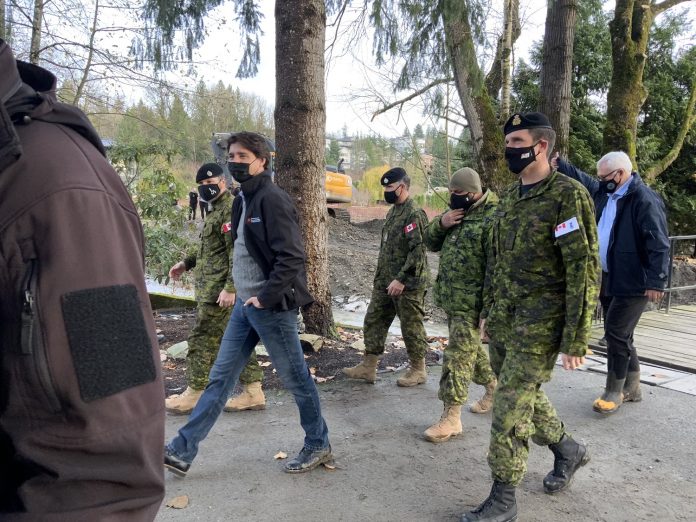
THREE BC municipalities devasted by flooding in 2021, along with industry and business leaders are calling on the federal government to change the way it funds climate change disaster prevention after all being turned down for critical flood infrastructure funding through the Disaster Mitigation and Adaptation Fund (DMAF).
The federal government launched the $2 billion DMAF in May 2018, adding an additional $1.375 billion in 2021, all of which is to be allocated over the next nine years. DMAF is a national, competitive, and merit-based contribution program requiring communities to apply for funding through a competitive applications process.
“It’s absolutely ridiculous,” said Abbotsford Mayor Ross Siemens on Monday. “The 2021 flood caused significant damage to our regional and provincial transportation infrastructure, property and businesses, and severely impacted agricultural production in the most productive area of Canada. For the first time in our history, we witnessed a nine-day closure of the key transportation corridor (the Trans-Canada Highway) through the Fraser Valley, which links Canada’s largest port with the interior and Alberta, and yet through this competitive granting program, we did not make it on the list of federal priorities.”
The City of Abbotsford in a press release noted that across BC, the 2021 atmospheric river event disrupted major railway lines, closed several major highways – some for several months, halted the movement of people, goods and services, resulting in severe disruptions to the Asia Pacific gateway supply chain, closed the US/Canada border, and devastated businesses, farms, residences and distressed residents. In Merritt, for example, this storm necessitated dozens of swift water rescues, and caused the flooding of hundreds of homes, months of lost school days, and hundreds of millions of dollars in destruction, including a bridge collapse, a wastewater treatment plant failure, and extensive private and public property damage.
Post flood, the City of Abbotsford took immediate action to assess and develop a flood prevention and management infrastructure solution that would safeguard the community, residents, and the region’s well-being and economic stability. The City applied for DMAF funding when the grant program opened for applications in the summer last year as encouraged by senior government officials.
The City of Merritt developed a comprehensive Flood Mitigation Plan to support their DMAF application. This plan provides updated river modelling that details that a much greater number of homes are now at risk (1,270 homes are now identified as in the flood zone compared to the 130 homes previously identified in the original Provincial floodplain modelling). The flood protections that Merritt had prior to 2021 are now washed down the river and the city remains extremely vulnerable to future and inevitable flooding. The City of Merritt needs a new dike system plus the funding required to purchase the land under its footprint.
The Town of Princeton hired a consultant to update the municipality’s current flood mitigation plan and embarked on a long-term hydrological model simulation identifying the magnitude of future winter and rain events in the vicinity of the municipality. The plan includes options for future diking projects and relocation of key infrastructure.
However, the competitive DMAF requirements mean that municipalities have to compete for the funding with all other communities across Canada. With limited financial means and expertise, this means smaller municipalities and communities do not always have the resources needed to undertake the lengthy and sometimes costly process of preparing an application that stacks up against other applicants competing for the funding.
“Senior levels of government promised to support us. They told us this was the way to get it,” said Merritt Mayor Michael G. Goetz. “We have shared detailed engineering reports that say the return-on-investment of this design is 7:1. Honestly, if preventing an almost guaranteed future disaster with a project like this doesn’t make the cut, I can’t imagine what projects in Canada will.”
“It’s like hoping to win the lottery,” said Princeton Mayor Spencer Coyne. “Community members lost their homes, key infrastructure was impacted, and the community was devastated. The DMAF funding was key to the flood mitigation and adaptation plan of Princeton, but now we are left vulnerable and trying to find a way to pay for the impacts of global climate change on our own with a population of 3,000 and tens of millions of dollars in costs. Rural BC, no, rural Canada is the economic engine of this country and cannot be forgotten just because we might be small.”
In 2019, the Federation of Canadian Municipalities (FCM) recommended that the federal government “reevaluate” the DMAF program’s eligibility criteria so that communities of all sizes could “access critical funding and support”, yet no changes were made.
Abbotsford’s funding application proposed a solution that would ensure the Trans-Canada Highway would remain open, BC’s provincial food supply would be protected, and ensured that the flow of goods and services by truck and train to and from the Port of Vancouver would continue.
Merritt’s application proposed a system of setback dikes that would increase riparian area, provide room for the river, and provide safety and protection for the thousand-plus residents who now find themselves in a flood inundation zone after modern engineering projections tripled the potential flood levels.
Princeton’s application proposed structural and non-structural elements, including land acquisition for diking to protect the community, as well as the relocation of critical infrastructure (sewer lift station). With the anticipated increase in winter flooding events, similar to the one experienced in November 2021, a 1.642-km dike is paramount for preventing overland flooding in the future.
The 2021 floods have been called the most expensive natural disaster in Canadian history, leaving the three mayors wondering, if work to protect against this level of disaster doesn’t qualify for federal support, then what does.
In June 2023, Canada’s first National Adaptation Strategy was released by the federal government. Disaster resilience is one of the five key systems around which the strategy is organized.
Despite preparing such resilience strategies, Abbotsford, Merritt and Princeton are left wondering how they will be able to find the funding they desperately need to ensure their communities are prepared in the face of increasing extreme climate events.











